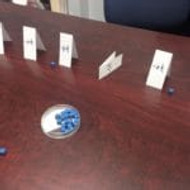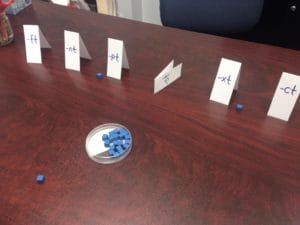Multisensory Monday- Phonics Bowling
Posted by Brainspring on 11th Jun 2017
Want a fun multisensory idea that you can customize for many Phonics First lessons? Try Identification Bowling! This game works great in small groups or in partners. You can use it to introduce a new concept or to review previously taught concepts.
This is one of my favorite multisensory activities because it practices listening and reading skills, has a visual component, and provides a fun gross motor activity as students work to knock down the cards.
To create the bowling cards, fold over several index cards and cut them into strips so that the cards stand up on their own (index cards or card stock work the best). Write the concept being identified on the cards. For the activity shown in the picture (Lesson 2-13 B), I wrote the ending –t blends on the cards, one blend per card. Small cubes, dice, a small ball or other small object can work well as the bowling ball.
To play, put students in partners or small groups and designate one student as the bowler and another as the reader. The bowler listens to a word and tries to knock down the corresponding card. For example, if studying ending –t blends, the reader might say the word, “next” and the bowler would try to knock down the –xt card.
To help things run smoothly, I usually provide the following guidelines:
- Rolling only, no flicking or overhand tossing (think bowling…you wouldn’t throw your bowling ball!)
- After 2 tries to hit the card, move on to the next word.
- Knocking down, bumping or touching the card with the ball all count as a hit.
- Keep score if desired or just play for fun.
- If having students work in pairs or small groups, designate how many words should be read before switching roles so everyone gets a turn to practice reading and bowling.
- To help keep the bowling ball from ending up all over the room, it is helpful to have the reader sit behind the line of index cards. That way when the bowler gets ready to roll the ball, the reader can put an arm behind the cards to try and stop the ball.
Based on what your students need, you can customize this game in many ways. This can be used to practice listening for single consonants (listen for beginning or ending sounds), consonant blends, c-le endings, and many other concepts. Happy bowling!
Audrey Bon, A.B.Ed.
Audrey is a tutor at Brainspring Learning Center in Plymouth.

